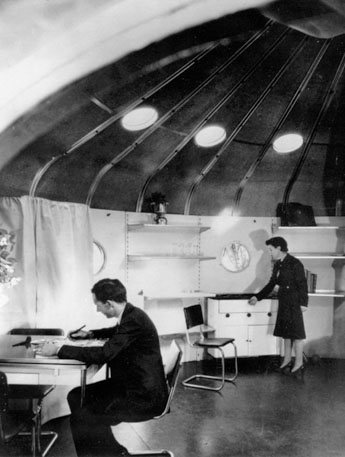Architecture
Dymaxion Deployment Unit (D.D.U.) - 1940
Richard Buckminster Fuller
USA
The word 'Dymaxion' is a combination of the words dynamic, maximum and ion. It was developed by a wordsmith, to qualify Fuller's inventions and designs, and was based on the typical language he used for presenting and explaining them.
The D.D.U. was designed as a mass-produced, low-cost residential unit, easy to disassemble and re-assemble. The unit was literary based on the grain silo, and produced by one of the biggest manufacturers of grain storage bins: the Butler Company. During the development process it became more and more a solution for emergency accommodation, much needed following the outbreak of World War II.
It was easy to build: first a temporary centre pole was placed, to which the roof was hoisted up. Underneath this roof the galvanised corrugated steel-plate outer walls were placed, because of their round shape forming a stable construction. On the inside, the walls were laminated with fibreglass insulation. The round windows were made of plastic, at that time only used in aircraft industry.
All utility spaces were pushed to the outer wall as much as possible to provide the maximum amount of space in the centre. Curtains could subdivide the interior in two bedrooms and a living space, and the main unit could be connected with a smaller one containing a larger bathroom or an extra bedroom.
With the Wichita House (1946) Fuller brought his ideas on the prefabricated 'dwelling machine' some steps further.
| Sources: | |
| Fuller Houses; R. Buckminster Fuller's Dymaxion Dwellings and Other Domestic Adventures Federico Neder Lars Müller Publishers, Baden, 2008 | |
| The Dymaxion World of Buckminster Fuller Robert W. Marks Reinhold Publishing, New York, 1960 | |
